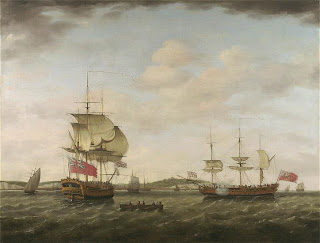Evan Nepean became Under-Secretary to the Home Department in 1783. As such he had responsibility for organising the transportation of First Fleet Convicts to New South Wales in 1786 and had considerable say in the selection of personnel. Partly through his influence Arthur Phillip was appointed Governor of the new penal colony and Major Robert Ross was given the post of Lieutenant-Governor and commandant of the Norine contingent that, theoretically, was supposed to help Phillip police the convicts at Botany Bay. Nepean first met Robert Ross during the siege of Boston, probably in late 1775.
On 5 December 1775 HMS Boyne left Boston for England, taking home General Johnny Burgoyne. Burgoyne would return to North America in May 1777 eventually to end his military career in ignominy. Evan Nepean, a clerk to the Boyne's Captain, Evan Hartwell, remained in Boston. and in January 1776 became secretary to Vice-Admiral Molyneux Shuldham , who replaced the cantankerous Graves.
Vice-Admiral Molyneux Shuldham's arrival could hardly have passed unnoticed by anyone since he had been greeted with the customary thirteen gun salute. His flagship, HMS Chatham moored northwest to the Long Wharf and south-south west off the formidable bastion of Castle Island. He was to take command of the North American Squadron from Admiral Graves, to the joy of every loyal subject in Boston. As Lord Percy observed, in sentiments undoubtedly shared by his young protege George Johnston and his future New South Wales colleagues, 'We wanted a more Active man than [Graves], for really the Service suffered material damage during his Command.' Graves would delay handing over to Shuldham until the end of the month, and that 'most unwillingly'. Once in charge Shuldham would, to the relief of the garrison,attempt a much more aggressive policy against the marauding privateers and the Americans' nascent Navy, keeping the sea approaches to Boston clear of any threat, but he was frustrated by their range along the New England coastline.
Under cover of the last night of a three night long night-long barrage on Boston and aided, despite the bright moon, by a heavy haze coming off the water, riflemen, and up to three thousand men, accompanied by 'three hundred loaded carts' carrying chandeliers, abbatis, gabions and fascines made over the previous half-month, sixty pulled by oxen, crossed the Dorchester peninsula. They climbed the Dorchester Heights. to the town's south on 4/5th of March 1776. Throughout the night they worked without stopping, able to throw up a works before sunrise strong enough to resist enemy shot. Atop the steep hills they surrounded the shallow breastworks with barrels of earth to be rolled down on the British as they made the steep ascent to take the fort. It was expected these rolling barrels would throw 'the assailants into the utmost confusion, and have killed and wounded great numbers.' Finally the big guns brought 300 miles from from Tconderoga by Colonel Henry Knox were slowly dragged up and mounted. Three hours after the operation began Brigadier-General Francis Smith, who had led the disastrous march on Concord in April 1775, was told 'the Rebels were at work on Dorchester Heights. Incredibly, he ignored the warning. Thus, on the morning of the fifth as the rebel bombardment sputtered to an end those who could sleep among the British garrison woke to find themselves threatened with complete destruction from encircling rebel batteries. One over-hopeful artilleryman burst 'three or four shells in the air' in the direction of the suddenly threatening southern heights
Howe's immediate response was to launch an artillery barrage against the new rebel stronghold. After two hours of fruitless attempts to elevate their guns high enough to reach the steep Dorchester Heights the general called an end to it. It was a waste of ammunition. By then, Vice-Admiral Molyneaux Shuldham, probably accompanied by his twenty-four year old secretary, Evan Nepean, had arrived to tell Howe that the Navy could not stay in Boston Harbor under the rebels' heavy guns. The fleet would be destroyed. Nepean did some quick calculations and concluded 'not less than 10-12,000 Men could have been employed in compleating such' an extensive breastwork. They must have, he thought, '7000 Men in the Intrenchments and as many to fall in from Roxbury.' Later that month, never one at this stage of his career one to annoy a potential patron, he passed the same information on to a discontented Admiral Graves. At an emergency War Council, at which Nepean may have been present, and which Shuldham certainly attended, though some were cautious, one senior officer urged Howe to storm Dorchester Heights and kill every rebel in sight, then burn Boston to the ground and go. At home Brattle Street deacon and selectman Timothy Newell fell to his knees and praised God,; 'for our redemption is near.'
The Marine Battalions did not take part in the proposed attack on Dorchester Heights; they were left to protect Boston's northern shores. At 11.30 a.m. five regiments began embarking on board five transports readying to drop down to Castle William, from whence they would cross to the Dorchester Peninsula. Howe himself, after rendezvousing with these transports would lead a flotilla of flat-bottomed boats, assaulting the heights from the south while the rest would attack on the north. The total number of troops engaged at this point was 2,500. By early afternoon the general decided to employ Lieutenant Colonel Musgrave's and Lieutenant Colonel Clark's regiments of Light Infantry, an extra 1,100 men. Ensign Francis Grose was with the 52nd in Clark's regiments. They spent the afternoon assembling at Barton's Point, marching to the Long Wharf so they were ready to embark by 7 p.m. At five Admiral Shuldham, Nepean close by, ordered a gun-boat and schooner in position to help protect the Army landing. Theoretically, the regiments were to be ready off Castle William to launch a full-frontal attack at 9 p.m. It was not a prospect that excited either officers or men, all of whom well knew breaching such commanding heights could only mean a death-toll worse than Bunker Hill, even under the cover of night. Francis Grose perhaps wondered if he would live through this night.On the hills around Boston 'Spectators in Abundance' gathered, waiting for the slaughter of the hated enemy. It began to rain, and with the rain came a rising wind, sleet and flurries of snow. From the rebel stronghold not ' shot or a shell' was fired as they hurried to further strengthen their redoubt before the British came.
A strong headwind slowed the expedition's progress to Castle William, and of those that reached there, some were driven aground. The surf dashing on the Dorchester Peninsula beaches was so high and rough it was impossible for the flat-bottomed boats to beach. By midnight this 'hurricane from the south' was blowing in windows around the harbor and tearing down sheds and fences. Howe had no choice but to delay his landing. Evan Nepean, on the Chatham, was not the only one who believed it fortunate it had been called off. One officer recorded with some relief that this 'wind more violent than anything I have seen ... saved the lives of thousands', a sentiment surely shared by Francis Grose.
The storm did not end until about sunrise the next morning. Aboard the Chatham Nepean was woken at three in the morning by the crash of the top mast with its yard, sail and rigging crashing to the deck in the 'hard gales and heavy Squalls.', damage not repaired til eight the next morning. On land, that morning, Howe explained in general orders that 'the intended expedition last night was inevitably put off by the badness of the weather.' All knew, as they watched the fortifications on the small hills grow stronger by the hour that Boston was becoming 'untenable.' Everything was to be embarked.
Everything could not be embarked. Howe had been ordered to evacuate Boston as early as October 1775 but he had delayed because of a shortage of transports. By the end of January he had a tonnage of 19, 765. For a complete embarkation he needed 8597 tons more. Expectations that he could make up the shortage with more transports out of provision ships were dashed when, instead these ships had been driven by storms to the West Indies. They were not due to arrive in Boston any time soon.
In the two or so days it took the Light Infantry to beat up from Castle William most of the heavy equipment and artillery was loaded onto waiting transports. Once back on land Grenadiers and Light Infantry were solely employed in loading the waiting ships.
On the tenth of March the first of the transports, crammed with panicked Loyalists, women, children and the wounded, worked down to King's Road near Castle William under the protection of the Chatham .There they would wait in the utmost discomfort for one more week before the fleet was ready to depart. The Americans viewed the movement with suspicion and rushed a detachment to Dorchester Neck against any proposed landing party. A few shots were exchanged. The rebels relaxed. From the quarterdeck of the Chatham. Evan Nepean probably watched, appalled by the waste and touched with compassion, as the various transport officers tossed 'All Household Furniture and ... useless Luggage' belonging to Loyalists overboard to make room for more essential items. With many transports crowding at King's Road it was not surprising accidents happened. HMS Centurion and the transport Senegal carried away the Chatham's 'Ensign Staff, Poop lanterns and a stove on the larboard Quarter Galley' tossing Nepean out of his hammock in the middle of the night.The ship's carpenter was busy for days making repairs, adding to the flagship's overcrowded unpleasantness.
Not until 4 a. m on 17 March with the Light Infantry on rear guard, did he embarkation finally get underway. As the vessels slowly moved away from the wharves at 9 a. m. toward the rendezvous at King's Road, one officer grumbled 'Never was an Army so Crowded in Transports owing to the want of Shipping.' Aboard thirty-eight transports were 8908 troops, 924 Loyalists, and much baggage and equipment. Left behind were many spiked cannon, scuttled brigantines and schooners at every wharf, including one 'newly-built', A 'Chariot' belonging to General Gage lay smashed on the Long Wharf. Much other equipment and stores were strewn around Boston, but apart from a plethora of timber and tons of sea-coal, there was little of much value.
As the evacuation fleet assembled at King's Road, the British blew up Castle William, determined to render it useless to the Americans. Howe and Shuldham, much to Washington's suspicion and impatience, lingered at King's Road until the 21st. They had discovered to their disquiet that much of the cargo had been badly stowed, making many ships dangerous to sail in anything but the calmest conditions. The Admiral realised they could not remain under the American guns without great hazard. At eight that morning he 'made the signal for all the fleet to sail down to Nantusket' Road, at the entrance to Boston Harbor. For those officers able to glimpse Boston as the transports drew away there was a sadness and an anger about what they had endured for so little purpose. Several thousand of their compatriots lay buried at Concord and Bunker Hill and in Boston itself. Few of the living would ever see Boston again. Thus, three hours after leaving King's Road, Shuldham's fleet moored at Nantusket Road.


